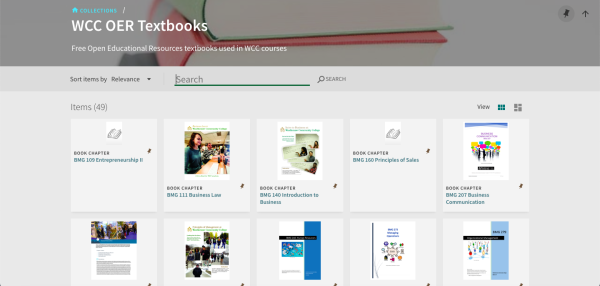
The Bailey Library catalog contains many OER sources. The “open access” filter under “availability” allows you to limit the results to open-access works. Jada Hauser | Washtenaw Voice
Open Educational Resources provide freely accessible materials anytime
Yana McGuire
Staff Writer
According to data collected from the Bailey Library, during the 2023-2024 fiscal year, WCC’s Open Educational Resources (OER) program saved students a total of $2,345,693.67.
The savings reached 8,800 students from 18 educational departments. There are 388 course sections that offer a more affordable approach to higher learning.
OERs are course materials that are freely accessible in the public domain at any time. Students can freely access the materials, and faculty can repurpose them to meet their students’ needs.
Molly Ledermann, WCC faculty librarian and the go-to source for faculty to create OER for their courses, states that there will be faculty members working on four to five more OER courses to be added to the 2025-2026 school year schedule.
Surpassing the one Z-Degree by 2023 goal, Ledermann has worked closely with WCC instructors and advisors to develop three Z-Degrees that allow students to obtain an associate degree with little to no book cost. In addition, six business certificates offer a total of OER courses.
WCC communication instructor Claire Sparklin has created two OER course materials and states that it takes a lot of hard work. However, she feels like it is well worth the time since it brings value to her students’ lives.
“Saving students’ money without sacrificing the quality of the textbook, knowing that my students are able to afford groceries or sign up for another class or just be able to live a fuller life by me choosing a textbook that’s free to them is definitely the major motivator,” she said.
Sparklin became interested in creating her own OER after her colleague, Bonnie Tew, a communication instructor, took a sabbatical to create the first OER at WCC in 2015. The OER was for the interpersonal communication course.
“I started using Bonnie’s OER in my classes. They [the students] were so overwhelmed with gratitude for not having to spend the $225 that it would have [originally] cost them,” Sparklin said.
According to Douglas Waters, a business instructor, the use of OER gives him and other faculty the advantage of having more time to focus on teaching students than classic textbook course preparation would allow.
“I serve as lead instructor for some high enrollment courses and have the opportunity to train other instructors,” Waters explains. “In those courses, when you have a commercial textbook that usually comes with software, every semester, you have to connect with the other instructors to train how to use that software. And how to integrate it with Blackboard or Canvas. It’s a lot of extra administrative work, but when you have an OER that’s all eliminated. I’ll just send a new instructor a copy of the OER and PowerPoint slides. They have everything they need from day one.”
Ledermann believes that the ability to customize the course material is another benefit students receive while using OER.
“One thing that’s really great about OER is it gives faculty the opportunity to localize content,” Ledermann said. “We all know that students learn best when content feels relevant. So, they [instructors] can change the examples to reflect our students on our campus.”


